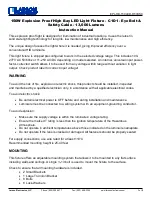
3-22
STEERING SYSTEM
The RT-300 steering system is a load-sensing, demand-type system that takes only as
much flow as is needed when steering and directs the excess flow to the control valve for
boom and outrigger functions. The priority flow-control valve is in the line between the 28-
gpm (106 L/min.) pump section and control valve.
Oil from the 28 gpm (106 L/min.) section of the pump goes into the priority valve at port
"P." When no steering is required, the entire flow goes through the priority valve and
leaves through port "EF" to the crane valve. The crane operating speed and power are not
affected, since there is no loss of volume or pressure by passing through the priority valve.
When the steering wheel is turned and steering power is required, the load-sensing line
signals the priority valve to divert the required amount of oil to the steering control unit to
meet the steering system requirements. The excess oil, not required for steering, flows to
the crane control valve as usual. Since the amount of oil required for steering is usually a
small portion of the pump output, the crane control valve is always operational while the
unit is being steered. Crane operation speed is reduced such a slight amount it is usually
not noticed.
The steering control unit is non-load reactive. This means that bumps, curbs, and
obstacles cannot change the steering angle and are not felt in the steering wheel. It also
means that the wheels do not recenter when the steering wheel is released. The steering
wheel must be turned back to center at the end of a turn.
There is a check valve in the pressure line to the steering control unit. This prevents
pressure in the steering cylinders from venting back into the pressure line when the
pressure is low. This eliminates steering wheel kickback when the steering wheel is
released.
The steering system pressure relief valve inside the priority valve is set at 2000 psi (138
bar) at the factory and should not need adjustment.
The three steering modes are selected by a switch on the dashboard which activates the
automatic alignment system. Electronic proximity sensors and logic controls delay the
switching of the steering mode until the wheels are centered. The proximity sensors should
be cleaned periodically with a rag to prevent dirt buildup from blocking their operation.
Summary of Contents for RT-300-2G
Page 6: ...1 2 DIMENSIONAL DATA Courtesy of Crane Market...
Page 7: ...1 3 RT 300 2G TURNING DIMENSIONS Courtesy of Crane Market...
Page 16: ...Courtesy of Crane Market...
Page 24: ...2 8 Courtesy of Crane Market...
Page 33: ...2 17 CAPACITY CHART FOR RT 300 2G Courtesy of Crane Market...
Page 34: ...2 18 CAPACITY CHART FOR RT 300 2G METRIC Courtesy of Crane Market...
Page 55: ...3 9 Courtesy of Crane Market...
Page 66: ...Courtesy of Crane Market...
Page 67: ...Courtesy of Crane Market...
Page 88: ...Courtesy of Crane Market...
Page 89: ...Powered by TCPDF www tcpdf org Courtesy of Crane Market...
















































